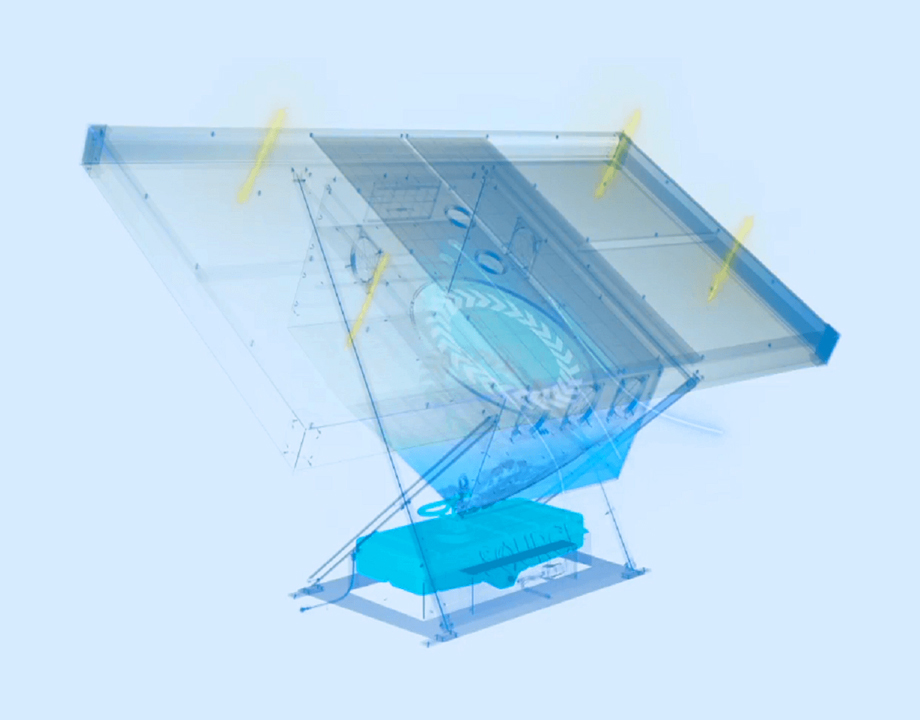6 Innovative Atmospheric Water Generators
6 Innovative Atmospheric Water Generators


AWG designs continue to improve, including the use of solar and power, new hydroscopic materials, and on-board filtering and sterilization technologies.
Date Updated: October 24, 2024
The supply of drinking water around the world is becoming endangered as populations increase, groundwater is depleted, and surface supplies shrink. While some believe that oceans could be tapped to solve this coming crisis—nearly 97 percent of the water on Earth is confined to the oceans but is of course too salty to drink—desalination is both energy intensive and costly.
In the atmosphere, however, are approximately 3,100 cubic miles of water vapor, which is almost enough water to fill the Great Lakes. Water vapor is an unlimited resource that is continuously replenished by the planet’s hydrologic cycles, so taking water from the air will not harm the environment.
Atmospheric water generators (AWG) are now being developed to squeeze water from the air. Many rely on standard condenser and cooling coil technology to collect liquid water. A major drawback is the large amount of energy consumed by these systems and their high operational costs.
The good news is that AWG technologies continue to advance, often using renewable energy to extract clean and purified water in surprisingly high quantities. Capacities range from home-based units of up to 20 liters per day to commercial and industrial systems that generate up to 10,000 liters or more per day.
Water production rates are largely controlled by air temperature and humidity. Ideal operating temperatures are 21-32 ºC with relative humidity between 40 percent and 100 percent; some systems, however, can still produce significant water volumes in desert conditions of 15 percent to 20 percent.
More for You: Aquatic Weed Fuels Bioethanol Production
Condensing water from the atmosphere will be one of the most important innovations in the coming years as freshwater becomes more scarce and controlled due to overpopulation, government policies, geopolitics, and climate change. It has been estimated that nearly 90 countries will face severe water shortages by 2050, according to the UN University’s Canada-based Institute for Water, Environment and Health.
Therefore, demand for AWG is understandably high. AWG systems can provide a mobile, or even off-grid, reliable water supply and reduce the use of plastic in water bottles. In some cases, they can even reduce the need for expensive water infrastructure.
Here are six advances in AWG systems that go beyond standard air-conditioning practices and aim to provide condensed drinking water for water-impoverished regions around the world.
1. Arizona-based Source uses solar energy to power hydropanels that are completely off-grid. Solar-powered fans pull in ambient air and capture the water vapor in a hygroscopic (water-absorbing) material. The water vapor is then extracted and passively condensed into liquid water, which is then sterilized with a built-in ozone generator.
2. Researchers at the University of Texas, Austin, the University of Texas, Austin, have developed an inexpensive gel-film material that can extract water from the air in even the driest climates—about six liters of water per day from a relative humidity of only 15 percent. The material consists of cellulose and konjac gum; the open pore structure of the gum accelerates the moisture-capturing process, making it an ideal material for AWG. A slight heating of the cellulose is all that is needed to release the captured water.
3. Massachusetts Institute of Technology scientists have developed an AWG system that uses zeolite, an absorbing mineral compound, to collect water vapor from the air at night. During the day, heat generated from a solar collector plate releases the water from the material. Because zeolite is highly porous with a large internal surface area, it is capable of producing significant amounts of water from air with a relative humidity as low as 20 percent.
Reader's Choice: Engineers Set New Record fo freezing Point
4. Researchers at Pacific Northwest National Laboratories accidentally discovered that clustered carbon-based nanorods can adsorb water at low humidity. When the humidity is low, there is more space between the rods, allowing them to collect water from the air. However, as humidity rises, capillary action pulls the rods together, which expels any stored water. One possibility for the future is developing a nanorod membrane that captures water and later expels it as humidity changes.
5. WEDEW stands for Wood-to-Energy Deployable Water and is an innovative AWG that can generate 2,000 liters of water or more every day from organic trash. It was developed by Skysource, a California social impact enterprise. Plant or animal waste is placed in a shipping container, where a humid environment is created to produce biogas through decomposition. The decomposition process releases water vapor, which is trapped in the container and later extracted from the air. This device won the $1.75-million Water Abundance XPRIZE 2018 as the most feasible solution for addressing the global water crisis.
6. Fontus Airo, powered by a small solar-powered rechargeable battery, is a self-refilling water bottle that takes less than an hour to fill itself using built-in AWG technology. Humid air drawn into the device flows across hydrophobic bristles or “teeth” that condense the water vapor into water droplets. The water bottle produces about 0.5 liters of water every hour.
Editor's Pick: Three Advances in Water Purification
From residential use for a few people to providing drinking water for millions, AWG has an important global role to play in the coming years.
Mark Crawford is an independent technology writer in Corrales, N.M.
The supply of drinking water around the world is becoming endangered as populations increase, groundwater is depleted, and surface supplies shrink. While some believe that oceans could be tapped to solve this coming crisis—nearly 97 percent of the water on Earth is confined to the oceans but is of course too salty to drink—desalination is both energy intensive and costly.
In the atmosphere, however, are approximately 3,100 cubic miles of water vapor, which is almost enough water to fill the Great Lakes. Water vapor is an unlimited resource that is continuously replenished by the planet’s hydrologic cycles, so taking water from the air will not harm the environment.
Atmospheric water generators (AWG) are now being developed to squeeze water from the air. Many rely on standard condenser and cooling coil technology to collect liquid water. A major drawback is the large amount of energy consumed by these systems and their high operational costs.
The good news is that AWG technologies continue to advance, often using renewable energy to extract clean and purified water in surprisingly high quantities. Capacities range from home-based units of up to 20 liters per day to commercial and industrial systems that generate up to 10,000 liters or more per day.
Water production rates are largely controlled by air temperature and humidity. Ideal operating temperatures are 21-32 ºC with relative humidity between 40 percent and 100 percent; some systems, however, can still produce significant water volumes in desert conditions of 15 percent to 20 percent.
More for You: Aquatic Weed Fuels Bioethanol Production
Condensing water from the atmosphere will be one of the most important innovations in the coming years as freshwater becomes more scarce and controlled due to overpopulation, government policies, geopolitics, and climate change. It has been estimated that nearly 90 countries will face severe water shortages by 2050, according to the UN University’s Canada-based Institute for Water, Environment and Health.
Therefore, demand for AWG is understandably high. AWG systems can provide a mobile, or even off-grid, reliable water supply and reduce the use of plastic in water bottles. In some cases, they can even reduce the need for expensive water infrastructure.
Here are six advances in AWG systems that go beyond standard air-conditioning practices and aim to provide condensed drinking water for water-impoverished regions around the world.
1. Arizona-based Source uses solar energy to power hydropanels that are completely off-grid. Solar-powered fans pull in ambient air and capture the water vapor in a hygroscopic (water-absorbing) material. The water vapor is then extracted and passively condensed into liquid water, which is then sterilized with a built-in ozone generator.
2. Researchers at the University of Texas, Austin, the University of Texas, Austin, have developed an inexpensive gel-film material that can extract water from the air in even the driest climates—about six liters of water per day from a relative humidity of only 15 percent. The material consists of cellulose and konjac gum; the open pore structure of the gum accelerates the moisture-capturing process, making it an ideal material for AWG. A slight heating of the cellulose is all that is needed to release the captured water.
3. Massachusetts Institute of Technology scientists have developed an AWG system that uses zeolite, an absorbing mineral compound, to collect water vapor from the air at night. During the day, heat generated from a solar collector plate releases the water from the material. Because zeolite is highly porous with a large internal surface area, it is capable of producing significant amounts of water from air with a relative humidity as low as 20 percent.
Reader's Choice: Engineers Set New Record fo freezing Point
4. Researchers at Pacific Northwest National Laboratories accidentally discovered that clustered carbon-based nanorods can adsorb water at low humidity. When the humidity is low, there is more space between the rods, allowing them to collect water from the air. However, as humidity rises, capillary action pulls the rods together, which expels any stored water. One possibility for the future is developing a nanorod membrane that captures water and later expels it as humidity changes.
5. WEDEW stands for Wood-to-Energy Deployable Water and is an innovative AWG that can generate 2,000 liters of water or more every day from organic trash. It was developed by Skysource, a California social impact enterprise. Plant or animal waste is placed in a shipping container, where a humid environment is created to produce biogas through decomposition. The decomposition process releases water vapor, which is trapped in the container and later extracted from the air. This device won the $1.75-million Water Abundance XPRIZE 2018 as the most feasible solution for addressing the global water crisis.
6. Fontus Airo, powered by a small solar-powered rechargeable battery, is a self-refilling water bottle that takes less than an hour to fill itself using built-in AWG technology. Humid air drawn into the device flows across hydrophobic bristles or “teeth” that condense the water vapor into water droplets. The water bottle produces about 0.5 liters of water every hour.
Editor's Pick: Three Advances in Water Purification
From residential use for a few people to providing drinking water for millions, AWG has an important global role to play in the coming years.
Mark Crawford is an independent technology writer in Corrales, N.M.





